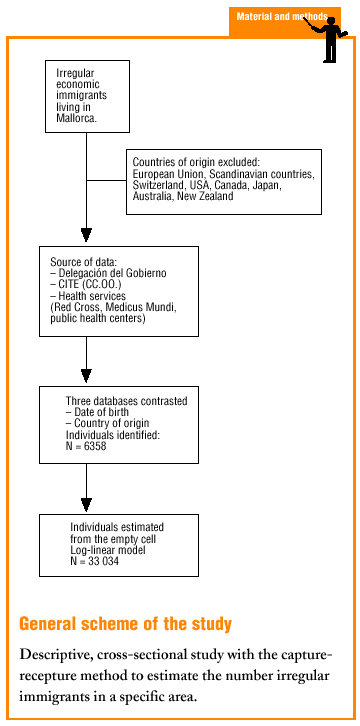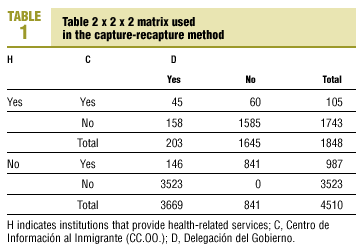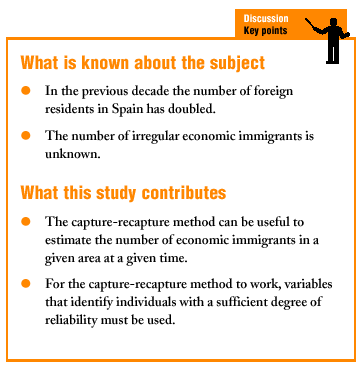Introduction
The number of foreign residents in Spain had doubled during the previous decade.1 Of the 938 783 foreign residents now in Spain, 55% are economic immigrants,2 ie, they are from countries that are economically disadvantaged in comparison to Spain. To this figure must be added an unknown number of irregular immigrants (with no residency or work permit); although several authors have estimated the number of such persons, the published figures are contradictory.3,4
In the Autonomous Community of the Balearic Islands there are 40 399 legal foreign residents, one third of whom are economic immigrants. The number of irregular economic immigrants in this community is unknown, although the Council of Social Wellbeing of the autonomous regional government estimates that there are 5000 such immigrants in the entire archipelago.5
The objective of this study was to estimate the number of irregular economic immigrants on the island of Mallorca.
Material and methods
This descriptive, cross-sectional study was carried out in Mallorca. The study population was all irregular economic immigrants residing on the island. Economic immigrants6 were considered those from any country that was economically disadvantaged in comparison to Spain. We therefore excluded immigrants from the European Union, Scandinavian countries, Switzerland, the USA, Canada, Japan, Australia and New Zealand.
We used the capture-recapture method, an indirect method based on contrasts of data from two or more sources.7-9 First we determined the numbers of individuals who appeared in only one of the sources consulted, and those who appeared in two or more sources. These figures were used to construct a matrix with 2k cells, where k is the number of sources of data. The empty cell, calculated with log-linear models.10 was taken to represent the number of individuals who did not appear in any source.
As data sources we used the Delegación de Gobierno (police and immigration authority) (immigrants who had applied in that year for residency or work permits), the Centro de Información al Inmigrante (CITE) run by Comisiones Obreras (labor union), and institutions that provide health-related services to immigrants (Red Cross, Medicus Mundi and public health services).
The police and immigration authority provided information on all immigrants who applied for regularization of their legal status during the special application period in the year 2000. The CITE, Red Cross and Medicus Mundi provided information on all immigrants registered with these organisms since they had begun to operate in the region. Public health services provided the numbers of immigrants who, between 1 January and 30 June 2000, had visited any of the five health centers that served areas with large numbers of economic immigrants or any of the emergency services of the island´s two public hospitals.
The variables used to identify individuals were passport number, date of birth, town or city and country of origin, and legal status. However, to maintain confidentiality of the data individuals were identified only by birth date and country of origin. This made it necessary to consider all records appearing in a given data base as (for example) «1/1/70 Morocco» as duplicates representing the same individual; although such records probably represented different persons, we counted such duplicate records as referring to a single individual.
The values for cells in the 2 * 2 * 2 table were calculated with the MS Access program, and the BMDP program was used to apply log-linear models to the data. The MS Excel spreadsheet program was used to select the best models on the basis of Aikake (AIC), Bayesian (BIC) and a modified Bayesian (BIC[Sin2Pi]) set of criteria.
Results
Table 1 shows the 2 * 2 * 2 matrix obtained by contrasting then data from all three databases (D, Delegación del Gobierno; C, CITE; H, health services). Source D identified 3872 individuals, source C 1848, and source H 1092. In all, 6538 individuals were identified. The 2 * 2 * 2 table was used to develop 14 log-linear models, and those models that best explained the characteristics of the data were selected. The CH, DC model yielded the lowest values, and was therefore the one that best accounted for the data. According to this model, the value of the empty cell, ie, the number of individuals not included in any of the databases, was 33 034. When added to the numbers of individuals identified in all three database, this figure gave a total of 39 392 individuals. This final figure can be considered the estimated number of all economic immigrants in Mallorca.
Discussion
Determining the number of irregular economic immigrants is a difficult challenge.11 The fact that different institutions in Mallorca provide services to immigrants was considered an opportunity to attempt an accurate estimate.
The capture-recapture method, developed in the field of zoology, has been used in epidemiology to calculate the size of special populations such as drug abusers12 and homeless persons,13 and to determine disease prevalences.14-17 We therefore wondered whether it would be useful in estimating the number of immigrants in a given setting.
Certain conditions must be met for the capture-recapture method to work. All individuals must have the same likelihood of being «captured»; the sources of capture must be independent; the population must be closed; and all individuals must be identifiable.7 In our study we assumed that all individuals had the same likelihood of using the services provided by the CITE, the nongovernmental organizations, the Office of Immigration (regional government immigration authority) and the health centers. We initially assumed that our method would estimate only the number of irregular economic immigrants. This error would have been avoided by stratifying the population,14 although heterogeneity does not always affect the results18.
The second condition need not be met when log-linear models are to be used. The third condition represents a theoretical assumption typical of epidemiologic studies, as it is currently difficult to find an entirely closed population.
The greatest limitation of this study was the unavailability of variables that would identify all individuals unequivocally. This was the reason why none of the models fit our data well on the basis of the maximum likelihood ratio. Consequently our results should be considered with caution until they can be confirmed.
The population of economic immigrants in Mallorca that we estimated with the capture-recapture method is 39 392 individuals. According to data provided by the Delegación del Gobierno,19 there are approximately 9000 regularized economic immigrants in Mallorca. Thus according to the capture-recapture method, the estimated population of irregular immigrants in Mallorca at the time of the study (July 2000) was approximately 30 000. In other words, the legal status of approximately three out of every four economic immigrants on the island was irregular.
Conclusions
The capture-recapture method can be useful to estimate the population of immigrants in a given area if institutions provide variables that identify persons with a sufficient degree of reliability.
Acknowledgments
We thank the Delegación del Gobierno of the Balearic Islands, the Centro de Información al Inmigrante, the Red Cross, Medicus Mundi, and especially Francis Alamino and Emilio Sánchez Cantalejo for their technical support.











